Joe Coogan Leaves Benelli to Follow His Heart Back to Africa
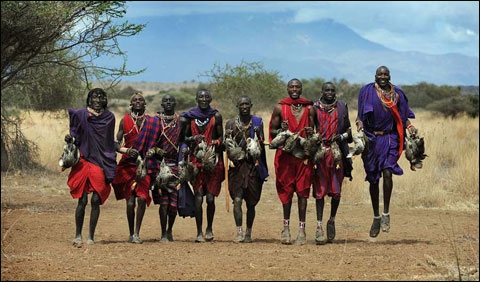
Africa is in the blood of Joe Coogan and now that he’s left shotgun maker Benelli USA he’s returning to the place that shaped him as a man.
Mr. Coogan, one of the last witnesses to the Golden Age of African safaris, is teaming up with his old-time friend and colleague Soren Lindstrom of Soren Lindstrom’s Africa to offer wingshooting adventures in South Africa, Botswana, Tanzania, Zambia, Zimbabwe and Namibia along with other hunting safaris. Mr. Coogan recently started Africa All Ways from his base in Merritt Island, Florida to support and represent Soren Lindstrom’s Africa here in the U.S.
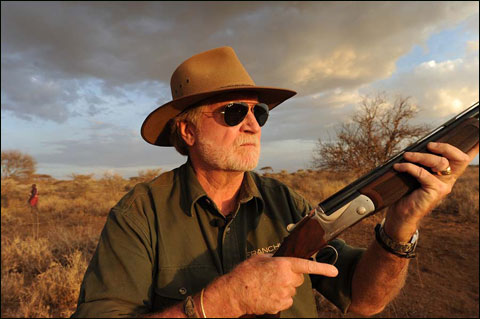
Joe Coogan hunting birds in Africa (photo: Stephen McKelvain).
Africa All Ways is another turning point in the extraordinary life story of Mr. Coogan. He left Benelli in June 2014 after eight years as Brand Marketing Manager and host of the popular cable TV show “Benelli on Assignment.”
“I stepped away from Benelli with opportunities in Africa that took me back to my roots,” Mr. Coogan said. “It was time to move on. I got a call from Soren Lindstrom and he asked me to get involved. He’s a professional hunter, outfitter and guide. I’ve known him going back to our Kenyan days until Kenya shut down hunting in 1979. I went to Botswana in October last year to visit with him and several other guys and we put our heads together. Birds are a significant focus in this new venture, along with big game and photo safaris.”
The bird hunting in Africa includes guinea fowl, francolin, spurfowl, sand grouse, doves, pigeons, ducks and geese. The various species are seasonal and migratory depending on nesting and weather conditions, especially with waterfowl.
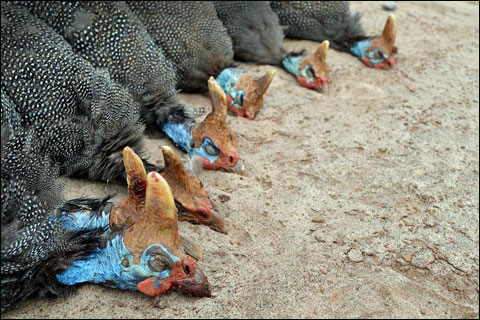
Helmeted guinea fowl are a common game bird in Africa (photo: Joe Coogan).
“There’s a lot of areas in the wild that are not perfectly predictable for bird hunting,” Mr. Coogan noted.
Unpredictability is Mr. Coogan’s stock in trade. He’s one of the last witnesses to the Golden Age of African safaris as embodied by the legendary professional hunter, Harry Selby.
Even though Mr. Coogan began hunting big game in East Africa with his father back in the 1960s, it was Mr. Selby who wrought the young man’s raw talent and steely nerves into a polished Professional Hunter.
“Selby was my mentor, boss, confidant and friend,” Mr. Coogan said. “He handed me the opportunity to live an absolutely incredible way of life.”

Joe Coogan (left) with Harry Selby on safari in Africa in 1975 (photo: Joe Coogan).
Mr. Coogan’s father had served as a career U.S. Navy pilot. In 1966, after retiring from the Navy, he put his flying experience to work with Pan American World Airways, re-locating the family to Mombasa, Pan Am’s base of operations on the Kenya coast. Mr. Coogan flew back and forth between Kenya and the University of South Florida in Tampa, where he studied mass communications and journalism, returning to Africa for summers and Christmas holidays.
The Coogan men took advantage of the enormous hunting opportunities that lay before them in Kenya’s hinterland, enjoying a period of time when the country’s ill-conceived hunting ban in 1977 was impossible to imagine. But before the Coogans could set out on their own they were required to pass grueling written and oral exams to qualify for their resident hunting licenses. Passing those exams, however, proved a significant turning point for the young, aspiring Professional Hunter to be. Now father and son could head out into the bush on their own, without a PH—imposing survival and dangerous-game experience on the twosome that would prove decisive for Mr. Selby giving the nod to Mr. Coogan.
“It was a different era back then,” Mr. Coogan recollected. “The scope of freedom we had doesn’t exist today.”
But when Mr. Coogan would tell people that he wanted to be a PH, in the eyes of so many experts, the door had already slammed on the iconic PH.
“They said I couldn’t do it,” he recalled.
From a historical perspective, the argument of those skeptics resonated the winds of change in Africa that swept through World War II, the bloody uprisings for independence from British, French and Belgian colonization, and carried the earliest whispers of animal rights activism.
In 1972, diploma in hand, Mr. Coogan returned to his beloved Africa to stay. But fate held even bigger things in store for him that year. A brief, but fateful, meeting in Nairobi with Harry Selby set the wheels in motion for the beginning of his PH apprenticeship several months later in Botswana. Face to face with Mr. Selby, Mr. Coogan was able to relate his prodigious years of experience in the bush with his father, Joe Coogan, Sr. In Mr. Coogan’s young mind, working under Harry Selby would be the equivalent of a garage band opening for the Rolling Stones.

Harry Selby (left) with Robert Ruark in Africa 1951 (photo: Harry Selby).
Some 20 years before meeting Mr. Coogan, Robert Ruark had immortalized Mr. Selby in his book, Horn of the Hunter. Mr. Ruark was already a famous writer, who habituated the upper echelons of New York society, pounding out critically acclaimed books and articles by day, and at night, when the lights were thrown on the Great White Way, socialized with his wife, Virginia, at high-society watering holes such as the 21 Club and the Stork Club.
Although the perennial life of the party, Mr. Ruark was possessed by demons from the Naval combat missions he participated in during the war. If you believe that war rouses the lord of creatures from the subconscious cave, then Mr. Ruark’s yearning for his first safari culminated from primal sensations rudely awakened by the deafening blasts of 20-milimeter, shipboard cannons during the war.
Describing his thoughts in Horn of the Hunter, Mr. Ruark wrote, “The hunter’s horn sounds early for some, I thought, later for others. For some unfortunates prisoned by city sidewalks and sentenced to the cement jungle more horrifying than anything to be found in Tanganyika, the horn of the hunter never winds at all. But deep in the guts of most men is buried the involuntary response of the hunter’s horn, a prickle of the nape hairs, an acceleration of the pulse, an atavistic memory of his fathers, who killed first with stone, and then with club, and then with spear, and then with bow, and then with gun, and finally with formulae. How meek the man is of no importance; somewhere in the pigeon chest of the clerk is still the vestigial remnant of the hunter’s heart; somewhere in his nostrils the half-forgotten smell of blood.”
And so in the early 1950s, his rifle experience no more than target shooting at the elite Campfire Club, Mr. Ruark booked a six-week safari with the prestigious African outfitter, Ker & Downey (K&D) Safaris to British East Africa (now Tanzania and Kenya). By pure fate, and the fact that Mr. Ruark requested to hunt with the PH who employed a recommended tracker named, Kidogo, Mr. Selby was assigned as Mr. Ruark’s PH, accompanied by a crew of experienced native helpers, including Kidogo.
Mr. Selby quickly gained Mr. Ruark’s respect, who described him thusly, “Selby is an extraordinarily handsome young man, with the kind of curly black hair and dark eyes that bring out the mother in women. He also has wrists as thick as an ordinary man’s ankles, and a hard mouth that turns down at the corners. In town, he looks like what the fagot writers call a “pretty boy.” Taking him into the bush, among the blacks and the beasts, and he is called ‘m’zee’ by natives. M’zee means old man. It means respected, ancient sir. It means wisdom and courage and experience. At that particular moment I decided that I had met few people with so much to admire and so little to worry about.”
After his safari with Mr. Selby, Mr. Ruark published a best-selling novel in 1955 called, Something of Value, which captured the horror and ramifications of the Mau Mau Uprising by Kenyan rebels against the British Colonial rule. It was adapted into a successful film starring Rock Hudson and Sidney Poitier. Seven years later, Mr. Ruark published Uhuru, not meant as a sequel to Something of Value, but along a continuing and similar theme. The follow-up novel portrayed Kenya after its independence, and it is said that characters based on Mr. Selby’s character and experience continued to appear in Mr. Ruark’s fiction.
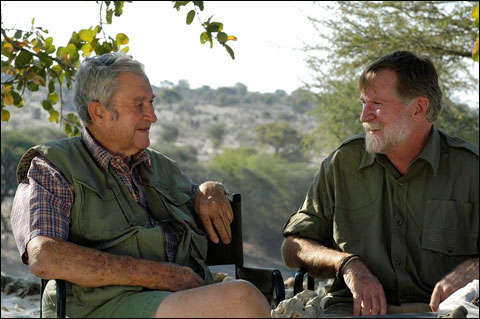
Harry Selby (left) with Joe Coogan in Africa 2008 (photo: Joe Coogan).
Mr. Coogan shared a similar sentiment: “Harry is a man of great confidence and capability. He possesses a world of knowledge about the bush. The chance to work with him was incredible.”
Mr. Selby’s first assignment for Mr. Coogan in Botswana was managing a photographic safari camp in the remote northern reaches of the country. “With my previous hunting and bush experience somewhat established, Selby wanted to see how well I could manage a safari camp and native crew, as well as guide and entertain the clients,” Mr. Coogan recalled.
Mr. Coogan was following along in the great tradition of the PH apprenticeship. Mr. Selby had earned his stripes as a PH by training under Philip Percival, the white hunter in Ernest Hemingway’s Green Hills of Africa.
Mr. Selby had grown up on a 40,000-acre cattle farm in Kenya where his family had resettled after leaving South Africa in the late 1920s. At the tender age of eight, Mr. Selby had been entrusted with his own .22 rifle. It was there that he forged his life-long kinship with Africans and lived among the impala, gazelle, zebra and elephants. The family also would hunt the occasional lion or leopard that fed on the family’s livestock.
Right after the war, Mr. Percival enlisted a young Harry Selby as a field mechanic, but it soon became apparent that Mr. Selby possessed the inherent hunting and interpersonal traits required of a first-rate PH. In 1945, with Mr. Percival’s support and endorsement, Mr. Selby received his first PH license. He was not yet 20 years old, and by the time he was 25 his reputation was well established. Just before the Ruark safari in 1951, Mr. Selby led a safari for Robert and Harriet Maytag in Kenya’s Northern Frontier District, a safari, which accounted for a great elephant whose tusks weighed more than 120 pounds each.

Joe Coogan (center in dark shirt) with a group in East Africa for the Benelli-owned Franchi shotguns that included Masai beaters (photo: Stephen McKelvain).
Now Mr. Coogan was working under Mr. Selby’s direction and supervision with Ker, Downey & Selby (KDS) Safaris in Botswana. Even as a camp manager, Mr. Coogan kept his finger in some hunting by providing camp meat to feed his safari clients and camp crew. At the end of his second season in Botswana, Mr. Selby invited Mr. Coogan to join him on an elephant hunt. It was during that safari that Mr. Selby offered Mr. Coogan the chance to join KDS the following season as a fully licensed PH. It was a testament to the clout and skill of the team, since PH licenses as a rule are issued only to hunters born and raised in Africa.
In 1974, Mr. Coogan took the helm of his first full-fledged hunting safaris in Botswana, which included hunts for dangerous game such as elephant, lion, leopard and Cape buffalo. Over time, Mr. Coogan would lead up to nine or 10 safaris per season, culminating in him spending 150 to 200 days in the bush each year. He conducted hunting and photographic safaris for KDS, and, later, Safari South, full-time for close to 20 years.
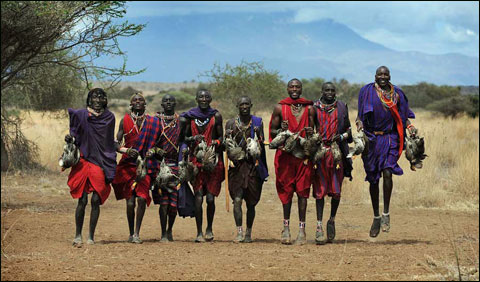
Masai beaters with yellowneck spurfowl from a Franchi hunt hosted by Joe Coogan in East Africa (photo: Stephen McKelvain).
“You become responsible for the lives of everyone in the camp,” Mr. Coogan explained. “The primary concern is the safety and well-being of the clients and upholding the law. You keep the vehicles running, stock supplies…hunting is only about 10 percent of what a PH does.”
Still, it’s a grueling 10 percent as described by Mr. Ruark in Horn of the Hunter…“Their average day starts at 4:30 A.M., and they rarely bed down before 11 P.M. During the course of a day they will drive a hunting car an average of 125 miles over trackless, tough terrain. They will walk an average of ten over mountains and through swamps, and they will crawl from one to five miles on their bellies. If you are hunting elephants you will walk from twenty to thirty miles a day over dry river beds that suck your shoes into the sliding softness and make every step a mighty effort. The sun smites like hammers all day long, and the nights, in most parts of huntable Africa, are bitter cold. After a full day’s work they are still supposed to supervise the constant necessary repair of the hunting vehicles, see that the camp is in good order, solve the problems of from one to a dozen natives, tend the sick, and still be jovial drinking, talking, and card-playing companions to the paying guests.”
For Mr. Coogan, though, the life of a PH was heaven on earth. “This is what I’d dreamed of doing,” he said.

A Masai beater posing with a Franchi Instict L over/under in a promotional hunt hosted by Joe Coogan when he worked at Benelli USA (photo: Stephen McKelvain).
Then in 1987, Mr. Coogan led Robert E. (Pete) Petersen, founder of the Petersen Publishing Company, and his wife, Margie, on a safari. At the time, Mr. Petersen was publishing some 20 magazine titles per month from a 20-story, high-rise office building in Los Angeles—reaping nearly $250 million in gross revenues.
“Pete’s company also published “Petersen’s Hunting Magazine,” a magazine I’d enjoyed reading for many years,” Mr. Coogan said.
Around the campfire, Mr. Coogan and Mr. Petersen discussed the possibility of Mr. Coogan moving to Los Angeles to join the company. The opportunity presented a stark contrast to the political and economic situation in Africa, and Mr. Coogan wasn’t quite ready yet.
“But by 1991, Botswana was changing many of its political policies,” Mr. Coogan explained. “And as a non-citizen, the licenses and permits were getting more and more difficult to obtain.”
So later that year, Mr. Coogan took a deep breath and accepted Mr. Petersen’s offer to join his magazine publishing empire. Finally putting his college education to work, he joined the editorial staff of “Petersen’s Hunting Magazine,” and remained with the magazine in Los Angeles for seven years.
In 1997, ready for a change from the “big city” life, he accepted a position with a Little Rock, Arkansas company, becoming involved with wildlife management on a 14,000-acre farm, located near Stuttgart—the self-proclaimed “Rice and Duck Capital of the World.” Mr. Coogan spent the next three years in Arkansas, before finally moving back to his home state of Florida to pursue freelance writing projects.
While writing magazine assignments, Mr. Coogan had a homecoming of sorts in Africa. His old safari company from Botswana had re-located to Tanzania and they contacted him with an offer that would put him “back in the saddle” of a PH. He passed the required PH exam and began conducting safaris again in Tanzania, East Africa with Tanzania Game Trackers (TGT) Safaris—spending four to five months in the bush each year through the 2005 season.
In 2006, Benelli USA contacted Mr. Coogan and invited him to join the company as their new Brand Marketing Manager. Shortly after Mr. Coogan’s coming aboard, Benelli was looking for a replacement of veteran actor Lee Horsley, who had hosted one of their first hunting reality shows, “Benelli’s Dream Hunts.” Once again, a break was parlayed into a career when Mr. Coogan helped develop and then host a new show called, “Benelli on Assignment.”
Mr. Coogan describes Benelli USA as “being on the forefront of TV and video production,” and he talks about the Benelli marketing and production teams in glowing terms. But hunting with Mr. Selby will always remain a cherished part of his life.
Throughout his hunting career, Mr. Selby always abhorred cruelty to the African animals he respected so highly. Mr. Ruark quoted Mr. Selby in the “Horn of the Hunter, “I can understand killing something you want so badly that you are willing to go to weeks of trouble and great expense to collect it, so that you will have it and enjoy it and remember it all your life. But this wanton stuff gravels the devil out of me. I hate conscious cruelty.”
Mr. Selby retired from professional hunting in 2000 after 55 safari seasons. In 2009, as one of the most revered names in big game hunting, was awarded the Presidential Certificate of Honor in recognition of long and faithful service to Botswana.
“I caught the tail end of the best hunting era in Africa with the best people,” Mr. Coogan said. “People with the qualities of Harry Selby, everybody, they were all top notch.”
Now with Benelli USA behind him, Mr. Coogan has returned to his first professional love.
“I’ve reached the point of moving back to my home state of Florida and reconnecting with my life in Africa,” he said. “I’ll be devoting more time to magazine articles and my autobiography.”
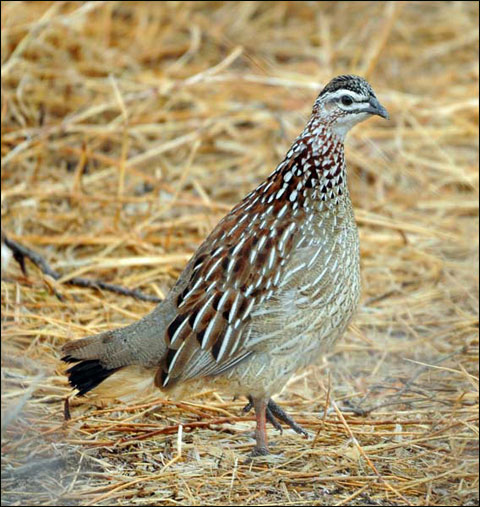
A crested francolin (photo: Joe Coogan).
Africa All Ways serves as the American liaison for Soren Lindstrom’s Africa by handling bookings, logistics and everything necessary to facilitate wingshooting safaris and other hunts in Africa.
For example, a 15-day safari of wingshooting and plains game for six to eight people will cost $660 per person per day or $9,900 total per person with all accommodations, meals, shooting licenses and permits and laundry. The bird hunting includes sand grouse, guinea fowl, spurfowl, francolin, pigeons, doves, ducks and geese. The species vary with the seasons.
Guests pay for international and in-country Africa flights, alcoholic beverages, trophy fees for plains game, firearm rentals, ammunition, gun permits in Botswana and trophy shipments.
For more information about hunting with Mr. Coogan, contact him at 321-480-2300 or joecoogan@icloud.com
Irwin Greenstein is the Publisher of Shotgun Life. You can reach him at contact@shogunlife.com.
Useful resources:
The web site for Soren Lindstrom’s Africa

Irwin Greenstein is Publisher of Shotgun Life. Please send your comments to letters@shotgunlife.com.


Comments